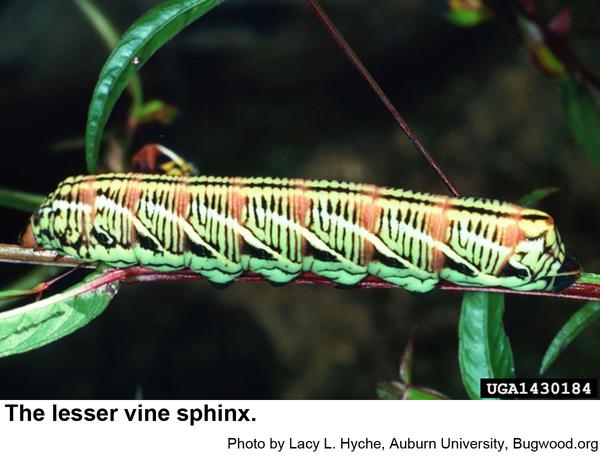Description and Biology
The banded sphinx moth, Eumorpha fasciatus, is a tropical species that sometimes migrates as far north as New England. It is also known as the lesser vine sphinx. Moths are sleek with a dark brown background and light brown to beige contrasting bands, and some narrow whitish lines. The moths have have two broad, pale bands on the fore wings, one parallel to the front margin and the other parallel to the outer edge. The hind winds have distinctive pink bands and patches. The wingspan is about 31/2 inches. Some moths have a distinctly green tinge. Eggs are spherical and smooth. Young caterpillars have a noticeable "horn" at the upper rear. Older caterpillars grow to about 3 inches ong and have greatly reduced "horns." In some, a small eyespot represents the "horn." Most banded sphinx caterpillars have black, white and red markings but this is one of the most variable caterpillars. Some are green, yellow, pinkish-red, yellow, or multicolored with red heads and legs. Some have a series of diagonal white lines down the sides and cross stripes across the top. A dark line down the back interrupts the cross stripes. Females glue eggs to the lower surface of foodplant leaves. Caterpillars feed on leaves and prefer the middle of the blade. Caterpillars usually grow through five stages of widely varying colors and patterns. Mature larvae leave host host plant to burrow into soil where they survive in an underground cavity. Pupae are dark brown to almost black. Pupae are spindle-shaped and have a small but distinct projection at the tail. Second generation caterpillars pupate during the fall or winter. New moths emerge the following May. We probably have two generations per year in North Carolina.
Host Plants
Banded sphinx caterpillars feed on evening primrose, Fuchsia, grape (and related plants in the genus Cissus), magnolia, Virginia creeper, water primrose, and water purselane. Moths sip nectar from whatever flowers they find in the evening and night.
Residential Recommendations
Although it is unusual to find banded sphinx caterpillars in the landscape, Sevin or most other insecticides labeled for residential landscape use should give adequate control.
Other Resources
- Banded Sphinx (Moth). Anonymous. 2020 (copyright). Butterfly Identification, Butterflies, Skippers & Moths.
- Eumorpha fasciatus (Sulzer, 1776). Anonymous. 2020 (copyright). Sphingidae of the United States of America.
- Species Eumorpha fasciatus - Banded Sphinx - Hodges#7865. Nendick-Mason, H. et al. 2019 (update). BugGuide, Iowa State University, Department of Entomology.
- NC State Extension Plant Pathology Publications
- NC State Horticultural Science Publications
- North Carolina Agricultural Chemicals Manual
For assistance with a specific problem, contact your local Cooperative Extension center.
This factsheet has not been peer reviewed.
Publication date: Sept. 9, 2020
Recommendations for the use of agricultural chemicals are included in this publication as a convenience to the reader. The use of brand names and any mention or listing of commercial products or services in this publication does not imply endorsement by NC State University or N.C. A&T State University nor discrimination against similar products or services not mentioned. Individuals who use agricultural chemicals are responsible for ensuring that the intended use complies with current regulations and conforms to the product label. Be sure to obtain current information about usage regulations and examine a current product label before applying any chemical. For assistance, contact your local N.C. Cooperative Extension county center.
N.C. Cooperative Extension prohibits discrimination and harassment regardless of age, color, disability, family and marital status, gender identity, national origin, political beliefs, race, religion, sex (including pregnancy), sexual orientation and veteran status.



